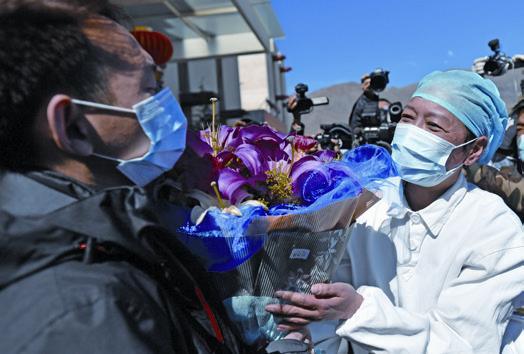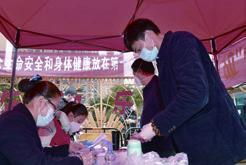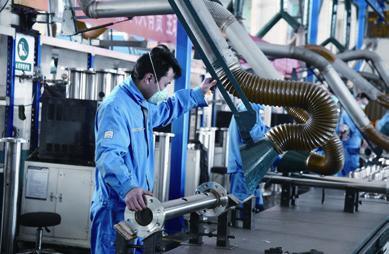BEING DISCHARGED
2020-02-26

The only patient infected with the novel coronavirus in Tibet Autonomous Region, southwest China, accepts a bouquet of flowers from the doctor in charge of his case after his recovery at the Third Peoples Hospital in Lhasa on February 12.
The 34-year-old patient, a tourist from Suizhou, Hubei Province in central China, arrived in Lhasa on January 24 for a pre-booked tour, and was confi rmed to have the virus soon after. He was discharged from the hospital after 18 days of treatment.
As of February 14, over 6,000 infected patients in China had recovered.

Adding a New Dimension
A worker at a company in Changsha, Hunan Province in central China, makes goggles for medical staff using 3D printing on February 11. The company started making the goggles after the novel coronavirus outbreak and can produce over 200 pairs using about 50 3D printers a day.
Ready for Tokyo
The list of 12 teams that will compete at the 2020 Tokyo Olympic Games has been fi nalized following the conclusion of the FIBA Womens Olympic qualifying tournaments.
China is one of the qualifi ers, along with Australia, Belgium, Canada, France, Japan, the Republic of Korea, Nigeria, Puerto Rico, Serbia, Spain and the U.S.
Under the current FIBA system, the top three fi nishers in each qualifying tournament are awarded tickets to the Tokyo Olympics.
China topped Group B in Belgrade, Serbia with a perfect record despite the loss of its home fi eld advantage due to the novel coronavirus outbreak, which led to the competition being relocated from the southern Chinese city of Foshan. China infl icted a rare defeat on world No. 3 Spain on its way to the Olympics.
Chinas Li Meng was awarded Most Valuable Player along with Emma Meesseman of Belgium, Sandrine Gruda of France and Nneka Ogwumike of the U.S.
The 2020 Tokyo Womens Olympic Basketball Tournament will take place from July 27 to August 9.
The 12 participating teams will be divided into three groups, with the top two teams in each group and the two best third-placed teams in the group phase advancing to the last eight.
Rare Birds Seen
Twenty-eight spoon-billed sandpipers, known offi cially as the eurynorhynchus pygmeus, a critically endangered bird species, were spotted in south China, local authorities said on February 10.
These small waders were discovered on the coastal mudfl at of Zhanjiang in Guangdong Province during a global survey on the winter activities of spoon-billed sandpipers and black-faced spoonbills on January 17-19, according to the provincial department of forestry.
The survey recorded 48 spoonbilled sandpipers in China. The species was classifi ed as critically endangered by the International Union for Conservation of Natures Red List of Threatened Species.
Sequence Shared
The genome sequencing of fi ve 2019 novel coronavirus strains at the National Genomics Data Center have been synchronized and shared with a U.S. database, according to the Chinese Academy of Sciences (CAS) on February 7.
The strains were provided by the Institute of Pathogen Biology under the Chinese Academy of Medical Sciences on January 26.
Through a data-sharing mechanism, the strains were synchronized with the GenBank database at the National Center for Biotechnology Information in the U.S.
Since the release of the database on January 22, the genome sequences of 82 virus strains worldwide have been collected and integrated.
With over 300,000 sequence fi le downloads, the database has provided services for over 30,000 visitors from 106 countries and regions, the CAS said.
Launch Preparations
Chinas Long March-5B carrier rocket arrived at the launch site in Hainan Province in south China on February 5 after a week of ocean and rail transport, according to the China Aerospace Science and Technology Corporation.
The rocket will take part in a joint rehearsal with the prototype of the Chinese space stations core module at the Wenchang Space Launch Center. It is scheduled to make its maiden fl ight and launch the prototype of Chinas new manned spaceship in April.
The Long March-5B is a modifi ed version of the Long March-5 rocket and will be Chinas fi rst 1.5-stage large carrier rocket, according to Wang Jue, chief commander of the Long March-5 rocket.
The rocket is 53.7 meters long, with a diameter of 5 meters and a liftoff weight of 849 tons. It uses pollution-free propellant including liquid oxygen, liquid hydrogen and kerosene. It has a carrying capacity of more than 22 tons in low-Earth orbit, the largest carrying capacity in low-Earth orbit among all Chinese rockets.
Hydrogen From Waste
Chinese researchers have developed a new method to produce hydrogen from the industrial waste of hydrogen sulfi de, according to a recent study published in Energy and Environmental Science.
The decomposition of hydrogen sulfi de obtained from industrial byproducts is a promising energy conversion technology for hydrogen production as the environmental pollutants can be simultaneously removed, the paper said.
The researchers, from the Dalian Institute of Chemical Physics under the Chinese Academy of Sciences, reported a remarkable metal catalyst encapsulated in graphene, a form of carbon, for highly effi cient hydrogen production from hydrogen sulfi de. The paper said the optimized catalyst delivered almost twice the current density than the platinumcarbon catalyst.
The new hydrogen production method was demonstrated to have potential for sustainable energy applications, it said.

Around the Clock
A worker is on the fl oor of Xinjiang Mengniu Dairy in Urumqi, Xinjiang Uygur Autonomous Region in northwest China, on February 10. The company has stepped up production to ensure supply during the novel coronavirus pneumonia outbreak.
Ocean Change
A Chinese research team has found that greenhouse gas emissions have played an important role in the acceleration of global ocean circulation.
A study by the team from the Institute of Oceanography of the Chinese Academy of Sciences found that the global average ocean circulation has accelerated signifi cantly in the past 20 years, which may lead to the reshaping of the global marine environment.
The fi ndings have been published in Science Progress, a subsidiary publication of Science.
The researchers made the fi ndings by integrating various data of ocean circulation and sea surface wind speed, and analyzing changes in ocean circulation on a global scale.
“Wind is the main power source of ocean circulation,” said Hu Shijian, one of the researchers. “The speeding up of sea surface wind has given rise to the acceleration of global average ocean circulation.”
“With increasing greenhouse gas emissions, more than 20 sets of numerical simulations show that the global average sea surface wind speed has signifi cantly increased, indicating that greenhouse gas emissions are the main reason for the acceleration of ocean circulation,”Hu added.
Wang Fan, director of the institute, said the acceleration of ocean circulation would lead to greater material and energy transport, potentially reshaping the global marine environment and exerting a signifi cant impact on marine ecology and Earths biochemical system.
Online Learning
The Ministry of Education (MOE) has asked colleges and universities nationwide to offer online teaching and learning resources following the postponement of school semesters.
According to a set of guidelines issued by the MOE, colleges and universities should make full use of all kinds of quality open online courses and laboratory resource platforms to organize online education activities.
Efforts should be made to ensure online learning is as effi cient as learning in the classroom, the guidelines said.
Offi cial data showed that as of February 2, 22 online course platforms had opened more than 24,000 free courses. They cover 12 undergraduate disciplines and 18 technical and vocational education majors.
In late January, the MOE announced the postponement of the 2020 spring semester for schools amid the novel coronavirus outbreak. It didnt specify the opening dates for colleges and universities under the ministry.

Safe and Sound
Residents of a community in Xihu District in Nanchang City of Jiangxi Province apply for community access cards on February 12. The communitys environment and residents health passed a recent assessment by epidemic control experts.
AIIB Loans
The Asian Infrastructure Investment Bank (AIIB) said on February 10 it is prepared to support China with public health infrastructure loans to meet the countrys immediate and longer-term public health needs.
The bank has been in active discussions with Chinese authorities to strengthen the emergency public health infrastructure, the AIIB said in a statement on its website.
“With the full impact of the novel coronavirus epidemic still unknown, we want to do our part as residents of China to help stop its spread,” said AIIB President Jin Liqun.
The bank will work with the Chinese Government to identify effective investments in public health infrastructure, as well as other multilateral development banks and private partners to join hands in bolstering China and other members ability to respond to and deal with epidemics and other public health emergencies, according to Jin.
These types of investments will not only improve the health of Chinese citizens but can have a global impact in terms of prevention and education, he said.
AIIB is a multilateral development bank that aims to support the building of infrastructure in the Asia-Pacific region.

Back to Work
Workers examine equipment in a factory in Qingdao, Shandong Province in east China, on February 9. Enterprises in the city resumed production on February 8 with tightened protective measures against novel coronavirus.
Shortening the Process
With the continued growth of the number of invention patent applications, Chinas National Intellectual Property Administration (CNIPA) said it will further shorten the process of patent review on February 8.
By the end of 2022, the processing time for an invention patent application will be cut to about 16.5 months and for a high-value patent to 13.8 months. The average time for processing a trademark application will be reduced to within four months, the fastest worldwide, according to a statement by the CNIPA.
China has attached greater importance to increasing the efficiency of patent review. Last year, the average processing time for trademark registration was shortened to 4.5 months, compared to six months in 2018, and the processing time for high-value patent examination was reduced by more than 15 percent to 17.3 months.
In 2019, more than 1.4 million invention patent applications were filed in the country, with 453,000 granted. The total number of effectively registered trademarks surpassed 25 million, according to the CNIPA.
High-value patents have been acquired mainly in the fields of artificial intelligence, mobile communications, high-speed railways and biomedicine.
Furthermore, the CNIPA has so far approved the establishment of 26 centers nationwide to solve the difficulties of providing proof and reduce the processing time and cost of intellectual property rights protection, the statement said.
Online Payment Surge
Card payment giant China UnionPay reported an increasing number of online transactions during the weeklong Spring Festival holiday.
From January 24 to 30, about 1.38 billion online transactions were made through its network, valued at 1.32 trillion yuan ($189 billion), data from the company showed.
The number of transactions surged by 13.21 percent year on year while the value marked a 13.3-percent rise, it said. Since the novel coronavirus outbreak, the company has stepped up efforts to ensure the orderly operation of the cross-bank transfer system and UnionPay payment services.
It has also strengthened the supervision of the network and transaction environment in Hubei Province of central China and other major epidemicstricken areas.
The company said that it would cut or waive service charges or crossbank cash withdrawal fees in these areas throughout the epidemic control period.
Halving U.S. Tariff Rates
The Customs Tariff Commission of the State Council, Chinas cabinet, said on February 8 that China will halve rates of additional tariffs on some U.S. products starting on February 14 in a bid to promote the healthy and stable development of Sino-U.S. economic and trade relations.
The move will halve the 10- and 5-percent rates on a list of U.S. products that were subjected to additional tariffs starting on September 1, 2019.
The list was part of a two-step tariff countermeasure targeting U.S. products worth about $75 billion. China suspended planned additional tariffs on products in the second list on December 15, 2019.
It decided to halve the tariff rates after the U.S. side announced on January 16 that it would halve its 15-percent additional tariffs on Chinese products worth some $120 billion on February 14, according to an unnamed official with the commission quoted in a statement on the Ministry of Finance website.
“To ease economic and trade tensions and expand cooperation, the Chinese side decided to adjust related measures accordingly,” the official said. “Further adjustments will mainly depend on future developments in the economic and trade relations between the two countries. It is our hope that both sides will work together toward ultimately removing all additional tariffs.”
The commission said other additional tariff measures will continue to be implemented as stipulated and work on tax exemptions for imports from the United States will proceed.

Robot Deliveries
A smart delivery robot from JD.com, a leading e-commerce giant, focuses on a delivery route in a community in Hohhot of Inner Mongolia Autonomous Region in north China, on February 7.
Smartphone Shipment Contracts
Chinas smartphone market declined 15 percent to about 85 million units in the fourth quarter of 2019, an industrial report showed.
Huawei maintained the lead in China with a 39-percent market share in Q4, up 11 percent year on year, according to data from global technology market analyst firm Canalys.
